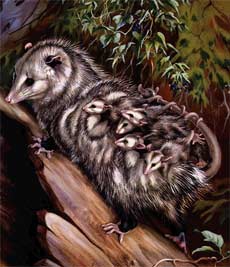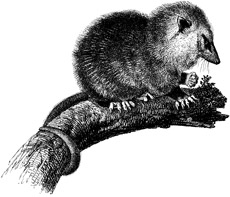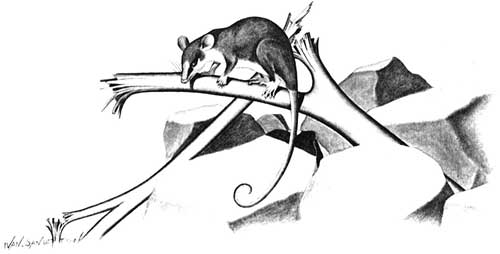|

Just the Facts: Opossums are small to medium-sized marsupials, about the size of a large house cat. They tend to be semi-arboreal omnivores, although there are many exceptions. Most members of this taxon have long snouts, a narrow braincase, and a  prominent sagittal crest. The dental formula (one side of one jaw) includes 5 incisors (four on the lower jaw), 1 canine, 3 premolars and 4 tricuspid molars. By mammal standards, this is a very full jaw. The incisors are very small, the canines large. prominent sagittal crest. The dental formula (one side of one jaw) includes 5 incisors (four on the lower jaw), 1 canine, 3 premolars and 4 tricuspid molars. By mammal standards, this is a very full jaw. The incisors are very small, the canines large.
Flat-footed: Opossums have a plantigrade stance (feet flat on the ground) and the hind feet have an opposable digit with no claw. Like some primates, opossums have prehensile tails. The stomach is simple, with a small cecum.
Birds and Bees: Opossum reproductive systems are extremely basic, with a reduced marsupium. This means that the young are born at a very early stage. The species are moderately sexually dimorphic with males usually being somewhat larger than females.

Not So Picky Eaters: Opossums are opportunistic omnivores with a very broad range of diet. Their unspecialized biology, flexible diet and reproductive strategy make them successful colonizers and survivors in unsettled times. Originally native to the eastern United States, opossums were intentionally introduced into the west during the Great Depression, probably as a source of food. Their range has been expanding steadily northwards, thanks in part to more plentiful, man-made sources of fresh water, increased shelter from urban encroachment, and milder winters. Their range has extended into Ontario, Canada, and they have been found as far north as Toronto.
 Always on the Move: Opossums are usually nomadic, staying in one area as long as food and water are easily available. Though they will temporarily occupy abandoned burrows, they do not dig or put much effort into building their own. They favor dark, secure areas, below ground or above. Always on the Move: Opossums are usually nomadic, staying in one area as long as food and water are easily available. Though they will temporarily occupy abandoned burrows, they do not dig or put much effort into building their own. They favor dark, secure areas, below ground or above.
Playing Possum: When threatened or harmed, they will "play possum", mimicking the appearance and smell of a sick or dead animal. The lips are drawn back, teeth are bared, saliva foams around the mouth, and a foul-smelling fluid is secreted from the anal glands. The physiological response is involuntary, rather than a conscious act. Their stiff, curled form can be prodded, turned over, and even carried away. Many injured opossums have been killed by well-meaning people who find a catatonic animal and assume the worst. If you find an injured or apparently dead opossum, the best thing to do is leave it in a quiet place with a clear exit path. In minutes or hours, the animal will regain consciousness and escape quietly on its own.
Tall Tails: Adult opossums do not hang from trees by their tails, though babies may dangle temporarily. Their prehensile tails are not strong enough to support a mature adult's weight, though they often serve as a brace and a fifth limb when climbing. There are also confirmed accounts of the tail being used as a grip to carry bunches of leaves or bedding materials to the nest.
Champion Immune Systems: Opossums have a remarkably robust immune system, and show partial or total immunity to the venom of rattlesnakes, cottonmouths, and other pit vipers. Thanks to their lower blood temperature, rabies is almost unknown in opossums.

All text is available under the terms
of the GNU Free Documentation License
|